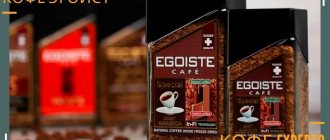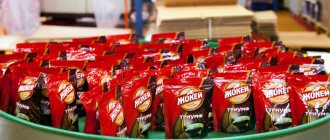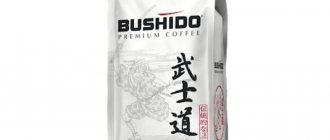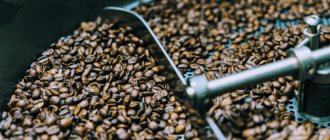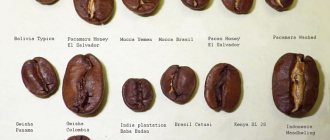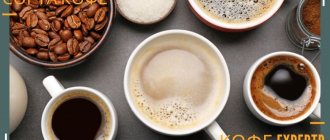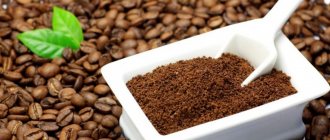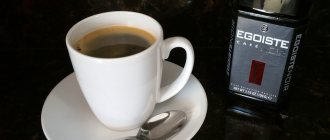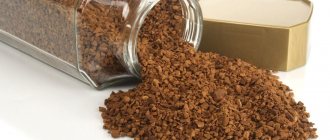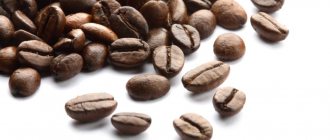Many of us brew aromatic, invigorating coffee every morning. It gives strength and energy for the coming day. A cup of coffee and a fresh croissant, what could be better? Now, there is a huge selection of coffee products on the market that differ in taste, quality and different prices. One of them is Nescafe coffee, which we will talk about today.
History of the brand
The brand name was formed by combining the words Nestle and Cafe, this happened in 1938. Nine years earlier, the Swiss company Nestle, led by Louis Dapplet, specializing in the production of baby food and condensed milk, made an offer they could not refuse. A large amount of coffee beans was stored in the Brazilian warehouses of the bank servicing the company. The crisis did not allow selling all stocks; a new harvest was on the way, and the remains of the old one could become moldy.
A large amount of leftover beans in the warehouse became the beginning of the production of a new type of coffee
In such a hopeless situation, the bank offered the then small company to expand its production range and, with the help of its chemists, create a product that would be stored for a long time and could be immediately consumed in dissolved form.
For these difficult tasks, the Swiss chemist Max Morgenthaler was invited to the company. He spent four years searching for the perfect instant coffee. Initial results were not ideal and had problems with solubility and lack of proper taste. Sugar and milk powder only made the situation worse.
It was only in 1937 that Max showed the finished product to the company's management, and in the spring of 1938 the first instant coffee under the Nescafe brand was presented to Swiss customers. Within a year the coffee was sold in Britain and the USA, and after another year it could be found in 30 countries around the world.
Instant coffee was first produced under the Nescafe brand.
After World War II, the new product began to take over the whole world. The company began producing not only instant coffee, but also related products: foaming blenders, coffee makers and coffee machines.
Brand history
The Nescafe coffee brand is the brainchild of one of the world's largest food manufacturers, Nestle. The brand appeared in the 30s of the last century and in just 2 decades won the preferences of buyers from 83 countries. And the reason for such rapid development was the appeal of the Brazilian Coffee Institute to the management of Nestlé with a request to help in the sale of surplus coffee beans, which at that time undermined the economy of the entire country.
At that time, instant coffee was already on the market, but due to its not very high taste, it did not gain popularity. The company's specialists, led by Max Morgentalen, have been working for 8 years to improve its taste and improve production technology. The result of their work was the first Nescafe instant coffee, which entered the markets of France, Great Britain and the United States, and production was established in the small Swiss town of Orb not far from Nestlé's headquarters. In the photo below you can see the image of the first can of coffee.
This is how the first instant Nescafe appeared on the market.
The manufacturer positioned its products as natural coffee, the composition of which does not contain other components other than coffee beans. This breakthrough was achieved through the creation of a new technology that did not involve the use of a carbohydrate base. Even later, in 1960, the company’s specialists learned how to flavor coffee, and later created the technology for producing coffee granules and freeze-dried products. This is how the world famous new Nescafe Gold appeared.
Today, the company has dozens of discoveries in the field of coffee, which have made the instant product the most popular and high-quality in the whole world. The company began producing luxury products, purchasing green coffee from farmers and planters without resorting to an intermediary. Thus, the company was able to offer the buyer a product for every taste and budget. For decades, the brand has maintained a leading position in the market, confirming quality and not stopping there.
Raw materials and production process
The most common coffee varieties are Arabica Robusta. Robusta beans are distinguished by a high caffeine content, which gives the coffee strength and a pleasant, rich aroma and bitterness. Arabica, on the contrary, is characterized by a small amount of caffeine and contains more essential oils. It has a mild taste and a sweetish aftertaste with sourness.
Coffee beans are carefully collected by hand
The process of collecting coffee beans has not changed over time. The grains are still collected by hand. They are then cleared of their outer shells. Next, usually by hand, the best quality grains are selected to go into production. The main plantations are located in Brazil, Indonesia, Peru, Colombia, Vietnam, i.e. in the coffee belt countries.
In coffee factories, instant coffee is produced mainly in two ways. The first one is more budget-friendly and is called agglomeration. The resulting beans are ground in large coffee grinders, the resulting powder is diluted with water, resulting in an extract that is exposed to hot air, the water from the solution dissolves and soluble coffee granules remain.
Grinding of grains is done in large machines
The second method is more modern - freeze drying. But its costs are significantly higher than those of agglomeration. The method involves freezing the coffee extract and then using hot air and vacuum to dehydrate the extract. The coffee breaks into small pieces that resemble broken ice. This type of preparation preserves the taste, aroma and beneficial properties of coffee as much as possible.
The company has opened 447 factories in 86 countries, employing more than 300 thousand people.
Nescafe range
The brand produces products from high-quality Arabica and Robusta coffee beans. The instant drink is more expensive than other brands because its production uses high energy intensity.
The drink is made in different degrees of roasting, so everyone will choose the option that suits them. The Nescafe company produces only natural, high-quality products that do not contain foreign impurities.
Nestlé produces the following varieties of coffee:
Nescafe Crema
The product was produced for connoisseurs of real coffee. The brewed drink has a delicate aroma, a classic rich taste, and an airy foam forms on top. For the production of Nescafe Classic Crema, selected varieties of high quality grains are used.
Nescafe Gold
Belongs to the class of elite drinks. Carefully selected beans give the brewed coffee a pleasant, delicate taste and vanilla aroma. Nescafe Gold instant coffee is packaged in 500 g cans, glass jars of 250, 100 and 50 grams, and you can also buy the product packaged in 150 and 75 grams.
Nescafe Gold Decaf
Thanks to special new technologies for manufacturing the product, coffee retains its taste, aroma and beneficial properties for a long time. Gold Decaf contains virtually no caffeine. It can be bought in glass jars weighing 50 and 95 grams.
Nescafe Classic
The most famous drink of this brand. It has a rich aroma and a slight bitterness in taste. It is made from Brazilian coffee blend, which is collected from the best coffee plantations. The classic is sold packaged in tins for long-term preservation of aroma and beneficial properties.
Nescafe Kulta
Coffee comes from Finland. Manufactured for sales in Finland and Sweden, where there is great competition between suppliers. The instant drink Nescafe Cult is one of the most famous in many countries. The brewed drink has a captivating aroma and unsurpassed taste that will give you a boost of energy throughout the day.
Nescafe Espresso
It is produced from the best varieties, with a dark degree of roasting. Thanks to the aromatic light foam and noble taste, Espresso is reminiscent of Italian coffee. The drink goes perfectly with cream and milk.
Nescafe Mocambo
It has a traditional taste and unforgettable aroma, thanks to the perfect combination of Arabica and Robusta. Its price is affordable not only for elite restaurants, but also for small coffee shops. The product is packaged in half kilogram packs.
Coffee rulers
There are a large number of Nescafe coffee lines around the world. Each of them has its own unique qualities, so everyone can find their favorite taste. Each region has its own individual set of product lines and types. There are 4 product lines in Russia: Gold, Classic, Sensa and 3 in 1.
NESCAFE Gold (Gold)
Made from Arabica and Robusta beans. It is one of the oldest types of coffee from the brand; it began to be produced back in 1965. The raw materials are characterized by ultra-fine grinding, which allows the taste and aroma to develop more strongly. It is considered a “premium” product, although it is not the most expensive. It has a pleasant caramel aroma during cooking. Due to its light roasting, it has a mild taste.
Nescafe Gold is made from a mixture of Arabica and Robusta.
This type of coffee is perfect for making Tiramisu cocktail. To prepare it you will need 90 ml of freshly brewed Nescafe Gold coffee, 400 ml of high fat cream, 40 ml each of Amaretto and Tiramisu syrup. Beat the syrups with cream and pour the resulting cream onto the coffee base. Decorate with cocoa if desired.
Nescafe Gold Barista (Gold Barista)
The granules are obtained by sublimation, which is why the cost is quite high. The beans are perfectly roasted and the finest Arabica beans are added to the finished product. The best grains are selected for the product and undergo the strictest selection. Strong coffee with a rich aroma.
Nescafe Gold Barista is made from ground Arabica coffee.
For those who like to experiment, Barakito coffee is perfect! To prepare a couple of cups of coffee you will need: 60 ml condensed milk, 30 ml coffee syrup, 120 ml Gold Barista coffee, 30 ml milk foam. Layer condensed milk and syrup, coffee and foam into cups. To serve, garnish with lemon zest.
Nescafe Gold Crema (Gold Crema)
The character of this drink is already reflected in the name - it has a soft, velvety foam that will allow you to fully enjoy the taste and aroma, and underneath it is bright, strong coffee. Belongs to the middle price category.
Nescafe Gold Crema forms a lush foam when brewed
What can you prepare for coffee with foam? Latte of course! It is necessary to brew 50 ml of coffee until foam forms, if desired, add 2 teaspoons of sugar for sweetness. Next, heat the milk to 60 degrees Celsius and beat half of it with a blender or mixer until foam appears. Pour the coffee into a cup of milk and carefully place the resulting foam on top.
Nescafe Gold Cappuccino (Gold Cappuccino)
One of the oldest names for coffee, as it began to be produced under the Nestle brand, the formula by which this coffee is produced now dates back to 1987. There are several subtypes of the drink on the market: with caramel or mild flavor, strong, classic and in 3-in-1 sticks. Many coffee connoisseurs like it for its simplicity, pure taste and voluminous head.
Aromatic coffee with milk foam, available in several packaging options
There are a lot of options for making cappuccino. Cappuccino with liqueur, ice cream, vanilla, cognac, and chocolate became widespread. For cappuccino with liqueur, you will need to brew 225 ml of coffee, 50 ml of heated milk, whip up the foam. Pour coffee liqueur and 50 ml of milk into a preheated ceramic mug and decorate everything with foam.
NESCAFE Classic
It can safely be called the most popular coffee of the Nescafe brand; it subtly captures the line between affordable price and good quality. Arabica and Robusta beans for coffee are grown on the best coffee plantations in Brazil. It is distinguished by a simple, but still recognizable bitter taste with a rich aroma. Perfect for many coffee drinks and a great way to invigorate you in the morning.
Classic is the basic taste in the Nescafe brand line
Nescafe Classic Crema
Combines the original taste and aroma of classic Nescafe and the tenderness and airiness of Gold Crema. For which you have to pay an above average price. Ready to drink on its own or in cocktails, ideally combined with sweets such as marshmallows or marshmallows.
Nescafe Classic Crema can be drunk with any sweet dessert
NESCAFE Sensa
Not so widespread and popular on the Russian market, unlike its counterparts. A representative of the premium segment, produced in the United Kingdom from Arabica beans. The most expensive of the brand representatives in Russia. Positioned as a drink straight from the best caffeine in the world. It has excellent foam and bright taste. You can choose Americano or Espresso.
Premium coffee, which is available in 2 varieties
NESCAFE 3 in 1
A quick option to boost your energy and quench your thirst at a low price. You can always take it with you on the road, since 3 in 1 is a ready-made combination of coffee, cream and sugar. Available in caramel flavor, in the classic version, cappuccino, Mild - the taste of delicate chocolate, and Strong - for those who like something stronger.
3 in 1 - an affordable coffee option sold in sticks
Reviews
Elena: Baristas prefer Nescafe; it appeared not so long ago, but it combines all the best from instant and ground coffee, which means quick brewing and a wonderful taste and aroma. I give it a 5.
Marina: Nescafe is truly the most recognizable coffee brand, no one even doubts it, so every trip to the store to buy coffee for the office ends with a can of Nescafe Gold or Classic.
Anton: It really looks like natural, I’m talking about the barista. It's a good idea to have a cup in the morning when time is short. The brand can be trusted, it has been on the market for so many years and without any scandals.
Irina: Now Nescafe has become an affordable product, although at the beginning of its mass appearance on the market it was expensive, I didn’t buy it, so I can’t see the changes in quality. Now I drink instant sometimes when I’m working and don’t have time to be distracted by Turk. So he suits me.
Reviews of Nescafe coffee
Customer reviews vary, because everyone has their own individual taste, but almost everyone does not remain indifferent to the already classic tastes of Nescafe coffee. Therefore, most people prefer this brand. Some people buy coffee because of the relatively low price, while others note that the manufacturer keeps the quality of taste high.
Some consumers do not find the coffee strong enough; some prefer to add milk and cream. But everyone agrees that the drink has a pleasant aroma. Most of the criticism is directed towards Nescafe 3 in 1, since it has practically nothing in common with real coffee, the taste and quality leave much to be desired.
Nescafe is the favorite drink of millions of people around the world.
Nescafe Espresso
Nescafe Espresso is selected Arabica beans, roasted to a dark color. This coffee is very similar to Italian, thanks to its strong, rich taste and delicate foam. The consistency of all grains is correct thanks to the latest technology based on the spraying of a liquid base. This type is most similar to freshly brewed coffee; it also goes well with cream and milk. Available in soft packages of 70 and 500 grams and in glass jars of 100 and 200 grams.
Counterfeits and how to spot them
Nescafe coffee is rarely counterfeited in large quantities. However, there are large quantities of counterfeit goods. So, from 2005 to 2006, a gang from St. Petersburg produced counterfeit goods and distributed them throughout major Russian cities. Production volumes were comparable to industrial production.
To distinguish the original from a fake, just look carefully at the packaging. It is necessary to pay attention to the price of coffee - a low price is a reason for caution.
Low-priced coffee may contain chicory or malt. The packaging will not be of the same quality and may lose its seal.
The markings on counterfeit cans are already on the cans, not glued on. It is extremely important to find the date, country of origin, and barcode. The first 3 digits of the barcode must match the country of origin code. And, of course, the taste, aroma and type of coffee granules will differ.
Also read about the origins of Dafidoff, Jacobs and Mehmet Efendi coffee brands.
Nescafe Classic
Brand owner: Nestle Food LLC Category: Non-alcoholic drinks Project scale: nationalMarketing Goal
Nescafe Classic is a traditional leader in the Russian agglomerated coffee market. Nescafe Classic is a brand that, due to historical factors, has the mission of building the instant coffee category in Russia. This important and influential factor was largely the reason that at a certain stage the concept of “instant coffee” was clearly associated with the Nescafe brand by a significant number of consumers. As a result, Nescafe Classic, as the largest brand in the Nescafe portfolio (and in the instant coffee market in general), began to be identified by consumers with the Nescafe umbrella brand. This has led to serious difficulties with the consumer defining the role of Nescafe Classic itself, its unique selling proposition (USP), and its image. In the consumer's mind, price became the main selection criterion, which, in comparison with other brands in the Nescafe portfolio, could negatively affect the consumer's understanding of the quality of the Nescafe Classic product.
Based on the above, the main marketing objectives were formulated as follows: 1. Clearly consolidating the new USP of Nescafe Classic in the minds of the consumer. 2. Strengthening the leading position in the assessment of such parameters as Spontaneous brand knowledge, and First mention of advertising in the category (an increase of at least 5%). 3. Creation of a new image of Nescafe Classic and clear differentiation of brand communication due to the growth of such advertising evaluation indicators as: "Accurate brand attribution" Slogan memorability ""Product action" "Consumption (place and time)" (all - an increase of at least 10 %).
In addition to the immediate goals of repositioning the brand, Nescafe Classic also has current goals: 1. Maintain and strengthen its leading position in the agglomerated coffee segment. 2. Ensure an increase in market share.
Review of the market situation. Brand positioning
The situation on the instant coffee market can be characterized by three main features: » Instant coffee occupies a dominant position in the Russian coffee market. » The market is developing at a fast pace and is characterized by large investments in marketing and advertising. » Distinctive features of the agglomerated coffee segment are accessibility to consumers, popularity, high profitability, and, accordingly, fierce competition.
The emergence of new aggressive coffee brands on the market significantly increased competition in the segment, which, together with the uncertainty in the positioning of Nescafe Classic in the minds of the consumer and his relationship with the Nescafe umbrella brand, clearly indicated the need to develop a new brand promotion strategy.
The new positioning was defined as Nescafe Classic - “Taste of the Beginning”; coffee that gives a start, awakens, encourages action. This positioning allowed: » First of all, to “stake out” the morning territory through the presentation of Nescafe Classic as an integral part of the “morning ritual” (research confirms that more than 60% of coffee consumption in Russia occurs in the morning). » Answer the key needs of the target audience. » Emphasize the high quality of the product. » Clearly differentiate Nescafe Classic from Nescafe and competitive brands.
Target group
The positioning of Nescafe Classic “Taste of the Beginning” is based on the following principle: no matter what gender, age, where we live or what we do, it is important that we all have a need to wake up, cheer up, mobilize, actively and positively start something activity (day). The study of coffee consumption motives allowed us to define the target audience of Nescafe Classic as “slumberers”: “All those who need a “stimulant” to get out of their morning sleepy state. » All those who need something to help them focus. » All those who need something that will push them towards a positive start to any activity. " All of us.
For these people, coffee, first of all, is a symbol of the beginning: the beginning of the day, work or any other active activity. It is important for them to know that they have a coffee brand that, thanks to its high quality products, gives them the opportunity to “get off to a great start” every day.
Within the Nescafe portfolio, Nescafe Classic's target audience represents a distinct group, which has served as the basis for the development of a clearly focused creative strategy. The target audience of Nescafe Classic is wider than the audience of the main competitive brands, and in addition, it is significantly different from them.
Creative strategy
Based on the brand positioning as “Taste of the Beginning”, the creative strategy was expressed as: “Great Taste! Great start!” (later became the slogan of the advertising campaign).
The campaign is based on the humorous story of two heroes working in the Arctic at a polar station.
Why the Arctic? » Using the “sterile”, snowy, free from fuss and social roles of the Arctic as a creative territory made it possible to simply and clearly convey all the advantages of the Nescafe Classic product. The emphasis is on coffee and its role as a stimulating, awakening factor, and not on surrounding objects and actions, which fade into the background in the harsh and ascetic conditions of the Arctic. The story is based on a simple technique of playing with morning rituals, familiar to almost every person, in which coffee makes it possible to cope with morning “problems” in the most positive and even creative way and start the day full of vigor, interestingly, with enthusiasm.
» Another important point in choosing the Arctic as a creative territory is that in Russia the image of the Arctic and the associated memories of the heroic past of Soviet science, the exploration of the North Pole, and expeditions are well known and understood by the older generation (the main consumers and buyers of Nescafe Classic) . For the younger generation (Nescafe Classic potential), the Arctic is a symbol of an extreme environment where only the strongest in body and spirit survive.
The creative task was to build a unified, clear and simple communication with a consistent development of events. As a result, a television campaign of 5 30″ commercials was developed - 4 videos of the main (image) communication (Getting Acquainted, Exercise, June 1, Shower) and 1 promotional video (“Collectible red Nescafe mugs”), as well as printed materials at points of sale, advertising in the press, on radio, on the Internet and outdoor advertising.
Communication strategy The basis of the communication strategy was the principle of conveying ONE, SINGLE idea through all channels involved, ensuring the possibility of consumer contact with the brand almost all the way “from the sofa to the product on the shelf.”
Media strategy
The media strategy of Nescafe Classic 2003 was determined by three main planning principles:
1. Convey a new communication idea through the media within the budget 2. Select a suitable place and time of advertising, taking into account the place and time of coffee consumption 3. Provide enough contact with the audience so that the new communication is understood and accepted by the target audience
Media Selection
During media planning, an integrated approach was chosen to achieve the most effective qualitative and quantitative contact with the audience: » Television is the main media medium for building the image and knowledge of the brand and ensuring the most effective coverage of the target audience at the national level with the lowest cost per 1000 contacts » Placement in weekly publication “Big City” to create excitement around the upcoming launch of a new campaign. » Outdoor advertising uses large formats to create a sense of strength and scale of the new brand image » Placing commercials in cinemas, as one of the most popular places for young people to spend time, allows us to recruit new Nescafe Classic consumers. » A number of tactics were used to increase the frequency of consumption of Nescafe Classic, when the method of communication corresponded to the moment the need for the product arose: o A commercial on the radio in the morning - to build an association with the idea - “Great taste! Great start!” o Banner campaign on the Internet - to increase consumption of Nescafe Classic in the workplace, o 5-second commercial on TV, opening an advertising block during the period of maximum television viewing (evening prime time) and encouraging you to prepare a cup of Nescafe Classic during the “commercial break”.
Implementation of television strategy
» Constant presence on air throughout the year - 39 active weeks. To achieve an optimal balance between long-term presence and required weekly weight, breaks of 1-2 weeks were allowed. » To maximize the potential of each video, a strategy of sequential launch of videos was chosen. » Each video is on air for the optimal number of weeks - 5. » Dominant position on air (minimum 200 GRP per week).
Media channels used:
Television Radio Points of sale Press Outdoor advertising Public relations Internet Advertising on cinema screens
Methods of PR, sales promotion, direct marketing, etc.
» Morning tastings on the streets of 15 key Russian cities. During the first half of 2003, more than 6 million people tasted Nescafe Classic as part of the “Great Taste! Great start!” (back packers). » Other tasting programs: shops, open markets, cinemas, tasting trucks on the streets. » Programs aimed at attracting the attention of sales representatives: to announce the scale of the campaign and stimulate sales representatives, letters from the heroes of the “Arctic” campaign were sent to key partners, and VIP partners also received a “NZ” gift from Nescafe Classic (see the “Getting Acquainted” video ). » Promotional campaign “Collectible Red Mugs” with national coverage. By sending three membranes from 100 g of promotional cans, the first 300,000 participants of the promotion could win one of three collectible red Nescafe mugs, and have a chance to become the owner of one of three apartments.
Packaging » Clearly conveys the main communication idea “Great taste! Great start! » Includes design elements that have become an integral part of the new brand image (photos of polar explorers).
Materials distributed at points of sale » Perform a communication function, rather than simply informing about the product. » Corresponds to the new brand image as a product of excellent quality. » Meet two main goals: o Motivation for purchase (by the consumer) o Motivation for purchasing volumes of product (sales representatives)
Sponsorship » To strengthen the image of Nescafe Classic as a brand that helps start the day positively, Nescafe Classic sponsors the program “Morning on NTV”, naturally supporting the presenters working live. » To attract a youth audience and maintain the Taste of the Beginning positioning by presenting the brand as a reliable foundation for many positive endeavors, Nescafe Classic sponsors the Alumni Ball in Moscow, as well as the Clean Energy snowboarding festival.
results
Just three months after the launch of the new communication, marketing goals and objectives were exceeded:
Brand performance: » Spontaneous brand awareness increased from 44% (December 2002 - January 2003 (D-J)) to 50% (April-May 2003 (A-M)). » The first mention of a brand in a category is 2.5 times higher than that of competitors in the agglomerated coffee segment.
Advertising metrics: » First mention of advertising in the category increased from 9% (D-Z) to 15% (A-M). » The first mention of advertising in a category is more than 6 times higher than competitors. » Memorability of the slogan reached 33%, which is 24% higher than the figures for the previous image campaign (December 2002). » The Product Action score increased from 16% (D-Z) to 40% (A-M). ""Consumption (place and time)" - from 5% (D-Z) to 28% (A-M) "It's good to start the day with coffee" - from 0% (D-Z) to 8% (A-M) .
Sales figures
In April-May 2003, sales figures showed a 5% increase compared to the same period in 2002, while the agglomerated coffee market as a whole is stagnating.
Sources Brand tracking - IPSOS-FSQUARED custom market research Retail auditing - MEMRB INTERNATIONAL research and consultancy group
Nestle Ex factory data
